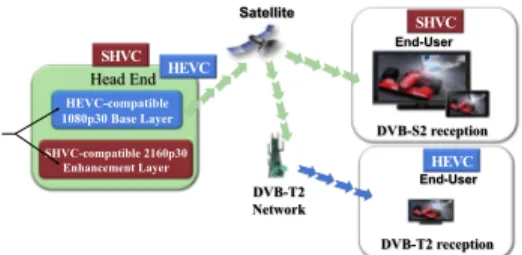HAL Id: hal-01068628
https://hal.archives-ouvertes.fr/hal-01068628
Submitted on 26 Sep 2014
HAL is a multi-disciplinary open access
archive for the deposit and dissemination of
sci-entific research documents, whether they are
pub-lished or not. The documents may come from
teaching and research institutions in France or
abroad, or from public or private research centers.
L’archive ouverte pluridisciplinaire HAL, est
destinée au dépôt et à la diffusion de documents
scientifiques de niveau recherche, publiés ou non,
émanant des établissements d’enseignement et de
recherche français ou étrangers, des laboratoires
publics ou privés.
4K real time video streaming with SHVC decoder and
GPAC player
Wassim Hamidouche, Gildas Cocherel, J. Le Feuvre, Mickaël Raulet, Olivier
Deforges
To cite this version:
Wassim Hamidouche, Gildas Cocherel, J. Le Feuvre, Mickaël Raulet, Olivier Deforges. 4K real
time video streaming with SHVC decoder and GPAC player.
Multimedia and Expo
Work-shops (ICMEW), 2014 IEEE International Conference on, Jun 2014, Chengdu, China.
pp.1-2,
�10.1109/ICMEW.2014.6890613�. �hal-01068628�
4K REAL TIME VIDEO STREAMING WITH SHVC DECODER AND GPAC PLAYER
W. Hamidouche, G. Cocherel, J. Le Feuvre, M. Raulet and O. D´eforges
IETR/INSA, Rennes, France and T´el´ecom Paris Tech, Paris, France
Wassim.Hamidouche@insa-rennes.fr
ABSTRACT
This paper presents the first 4Kp30 end-to-end video stream-ing demonstration based on the upcomstream-ing Scalable High effi-ciency Video Coding (SHVC) standard. The optimized and parallel SHVC decoder is used under the GPAC player to decode and display in real time the received SHVC layers. The SHVC reference software model (SHM) is used to en-code the 4K original video in two spatial scalability layers: the base layer at 1080p resolution and the enhancement layer at 2160p resolution. The SHVC bitstream is encapsulated with the GPAC multimedia library into MP4 file format. The GPAC player at the server side broadcasts the MP4 content in MPEG-2 TS. At the client side, the GPAC player receives the SHVC video packets which are decoded by the SHVC de-coder and then rendered in real time by the player. The GPAC player provides an interactive interface enabling to switch be-tween displaying the base and the enhancement layers.
Index Terms— End-to-end 4K video streaming, SHVC standard, parallel processingn, DVB-T2, DVB-S2.
1. INTRODUCTION
The Joint Collaborative Team on Video Coding (JCT-VC) de-fines the SHVC standard to enabling temporal, spatial and quality (SNR) scalability [1]. The SHVC extension is ex-pected to be finalized during the next JCT-VC meeting in July 2014. The SHVC standard is based on the HEVC technolo-gies and uses inter-layer predictions to take advantage of the spatial correlations. The SHVC coding into two layers in-troduces a rate-distortion loss of only 10%-30% in respect to the simulcast HEVC coding configuration [2]. Moreover, the SHVC standard supports the base layer coded in the legacy AVC standard. Therefore, SHVC extension can be an attrac-tive solution for several video streaming applications, includ-ing UHD-TV broadcastinclud-ing and IPTV or HTTP streaminclud-ing for UHD-TV. Figure 1 shows the SHVC video transmission over satellite and terrestrial broadcast networks. The idea behind this use case is to transmit at high bitrate two SHVC layers in separated PIDs over the satellite channel for full HD and 4K resolutions, respectively. Thus, end-users with satellite
This work is funded by the national FUI project OPTISAT2.
HEVC-compatible 1080p30 Base Layer SHVC-compatible 2160p30 Enhancement Layer Head End End-User SHVC HEVC DVB-T2 Network DVB-T2 reception Satellite DVB-S2 reception End-User SHVC HEVC
Fig. 1. SHVC broadcast over satelite and teresterial channels
receiver can decode both layers enabling to display the pro-gramme in 4K resolution. On the other hand, only one PID containing the base layer is retransmitted at lower biterate through the terrestrial channel. This enables end-uses con-nected to only terrestrial network to display the programme in full HD resolution. This use-case uses SHVC capability to adapt the bitrate of the video content to the channel bandwidth constraint, and avoids using resource-consuming transcoding solutions. This paper describes the demonstration of this use case on a computer with the SHVC x2 spatial scalability con-figuration: 1080p30 base layer and 2160p30 enhancement layer. This demonstration is carried out using only our open source software projects including the GPAC multimedia li-brary [3] and the optimized SHVC decoder [4]. First, the orig-inal 4K2K video is encoded with the SHVC reference soft-ware model version 4.1 (SHM) [5] into two x2 spatial scala-bility layers (full HD and 4K). The elementary SHVC stream is then encapsulated in two tracks MP4 file format with the GPAC player. At the server side, the GPAC player broadcasts the mp4 file format including the two tracks over the network in MPEG-2- TS format. At the client side, the GPAC player feeds the SHVC decoder with the received layers. The SHVC decoder decodes the two layers and pushes the decoded YUV picture corresponding to the highest layer to the GPAC player for rendering. The GPAC player can emulate the end-users connected to terrestrial or satellite networks by decoding only the base layer or the two layers, respectively.
2. OPTIMIZED SHVC DECODER
The received layers are decoded in real time with the op-timized SHVC decoder. We developed the SHVC decoder
Sequences Bitrate (Mbps) Decoding frame rate (fps) BL EL BL (HD) BL+EL (4K) CrowdRun 8.23 15.15 138 43 14.66 27.36 110 35 ParkJoy 9.94 21.91 134 41 19.68 41.69 93 33 Average 13.12 26.52 118 38
Table 1. Performance of the optimized and parallel SHVC decoder
on the top of the OpenHEVC project [4] which implements a conforming HEVC decoder. The SHVC decoder consists of independent OpenHEVC decoders, one decoder to decode each layer. A communication mechanism is implemented to perform the inter-layer predictions between the HEVC de-coders. All decoding operations including motion compensa-tion, inverse transform and up-sampling filters are optimized in Single Instruction Multiple Data (SIMD) Intel SSE meth-ods for x86 architecture. Moreover, the SHVC decoder is friendly-parallel and leverages multi-core architecture to im-prove both the decoding frame rate and the decoding frame latency. The SHVC decoder supports a hybrid parallelism so-lution combining the wavefront parallel processing soso-lution with the frame-based parallelism. This hybrid parallelism solution performs a high speedup performance with a good trade-off between decoding frame rate, decoding latency and memory usage [6]. Table 1 shows the performance of the SHVC decoder on a laptop fitted with a 4 Cores Intel i7 pro-cessor running at 2.3 GHz for two 4K video sequences.
3. 4K END-END SHVC VIDEO STREAMING In this section we provide the operation required to run the demonstration using the GPAC player and the SHVC de-coder on Windows OS. The GPAC installer release 5200 can
be downloaded from [3]. GPAC provides all executables
used in this demonstration including MP4Box, MP4Client and mp42ts. The 4K SHVC video bitsreams coded in two x2 spatial scalability configuration are attached to this paper. These bitsreams can also be encoded with using the reference software SHM4.1 [5] with the following command line:
TAppEncoderStatic -c /cfg/encoder lowdelay main.cfg -c /cfg/per-sequence-svc/ParkJoy-2x.cfg -q0 30 -q1 30 –NumLayers=2 –WaveFrontSynchro=1
The SHVC bitstream can be encapsulated into two tracks MP4 file format using the MP4Box executable as follows:
MP4Box -new -add ParkJoy 2160p.shvc:fps=30:svcm ode=split ParkJoy2160.mp4
In this example the server and the client run at the same
computer in localhost mode. This command line enables the server to stream the two SHVC layers:
mp42ts -prog= ParkJoy2160.mp4 -single-au -dst-udp= 224.1.1.1:1234
The client can decode and display the received SHVC lay-ers with the following command line:
MP4Client mpegts-udp://224.1.1.1:1234
The default configuration displays the highest decoded layer. However, the client can switch between the base and the enhancement layers by ctr+l and ctr+h, respectively. Fig-ure 2 illustrates the proposed demonstration displaying both HD (on the left) and 4K video sequence on a 84 inches 4K TV.
Fig. 2. GPAC player displaying 4K and HD video sequences on a 84 inches 4K TV
4. REFERENCES
[1] J. Chen, J. Boyce, Y. Ye, and M. M. Hannuksela, “Scal-able HEVC (SHVC) Test Model 4 (SHM 4),” in doc-ument JCTVC-O1007. Geneva, Switzerland, November 2013.
[2] V. Seregin, T. D. Chuang, Y. He, D. K. Kwon, and F. Le Leannec, “AHG Report: SHVC software,” in document JCTVC-L0011. Geneva, Switzerland, January 2013.
[3] “GPAC multimedia open source project,” in
http://gpac.wp.mines-telecom.fr.
[4] “Open source HEVC decoder (OpenHEVC),” in
https:://github.com/OpenHEVC.
[5] “SHVC Reference software model (SHM),” in
https://hevc.hhi.fraunhofer.de/svn/svn SHVCSoftware/. [6] W. Hamidouche, M. Raulet, and O. Deforges, “Parallel
SHVC Decoder: Implementation and Analysis,” in IEEE conference on ICME. Chengdu, China, July 2014.

